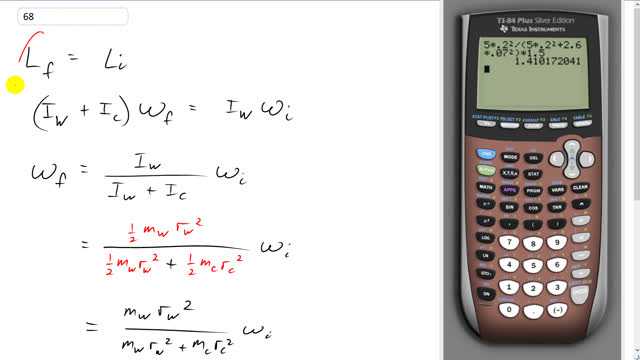
A potter’s wheel is rotating around a vertical axis through its center at a frequency of 1.5 rev/s. The wheel can be considered a uniform disk of mass 5.0 kg and diameter 0.40 m. The potter then throws a 2.6-kg chunk of clay, approximately shaped as a flat disk of radius 7.0 cm, onto the center of the rotating wheel. What is the frequency of the wheel after the clay sticks to it? Ignore friction.

In order to watch this solution you need to have a subscription.
This is Giancoli Answers with Mr. Dychko. Because there are no external net torques on this system, the angular momentum is conserved after the clay is put onto the potter's wheel the final angular momentum will be the same as the angular momentum of the potter wheel alone before the clay was put on. So L initial is going to be the moment of inertia of just the wheel times its angular velocity and then after the clay is put on, we have moment of inertia would be the total of the moment of inertia of the wheel plus the moment of inertia of the clay. and we can solve for ω f— the final angular velocity— by dividing both sides by I ω plus I c and we have final angular velocity is I w times ω i over I w plus I c. Now both the wheel and the clay are uniform cylinders so their moment of inertia formula's the same but we have subscripts that are different: we have mass of the wheel times radius of the wheel squared on top and then mass of the clay times radius of the clay squared on the bottom here and the one-halves cancel on top and bottom and we get this is our formula for the final angular velocity: mass of the wheel times radius of the wheel squared divided by mass of the wheel times radius of the wheel squared plus mass of the clay disc times the radius of the clay disc squared times ω i. So that's 5 kilograms times 0.4 meter diameter divided by 2 squared divided by the same thing plus 2.6 kilograms times the radius of the clay disc expressed in meters instead of centimeters so that's 0.070 meters, square that times by 1.5 revolutions per second and we get about 1.4 revolutions per second would be the angular velocity after the clay is put on the potter's wheel.
why didnt you convert the revs per second to radians per second?